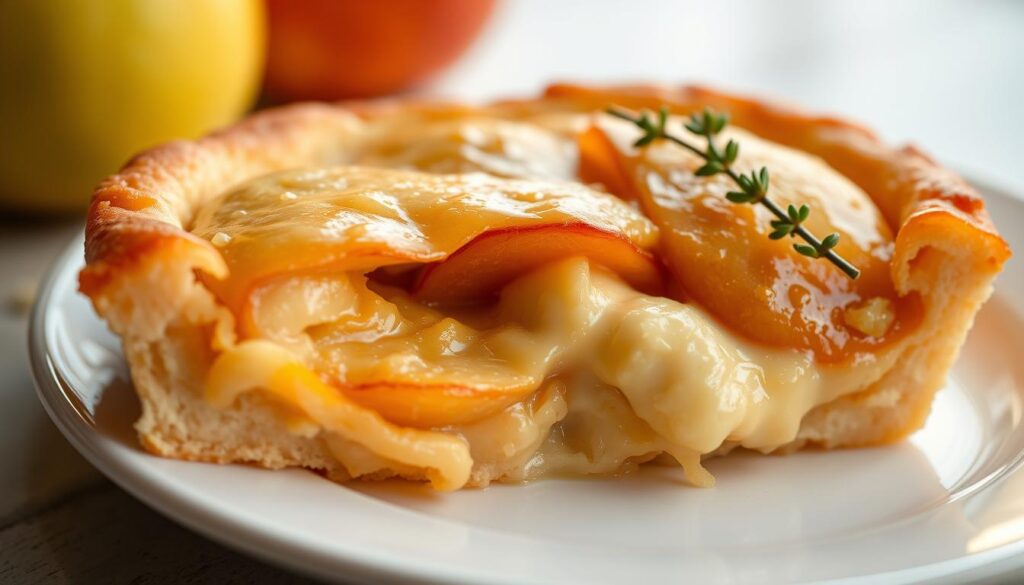At Historical Foods, we’ve perfected the art of creating exceptional apple cream by understanding the science behind this beloved dessert component. Apple cream combines the tartness of apples with the richness of cream, requiring a delicate balance of flavors and textures.
Our tested recipe has been refined through multiple iterations to ensure consistent results. By examining the chemical interactions between apple compounds and dairy proteins, we can achieve a signature smooth consistency.
The key to making great apple cream lies in selecting the right ingredients and mastering the technique. Certain apple varieties perform better in cream-based preparations due to their cellular structure, which affects the final texture.
Key Takeaways
- Understanding the science behind apple cream helps achieve consistent results.
- The right apple variety is crucial for the perfect texture.
- Chemical interactions between apples and dairy proteins create a smooth consistency.
- Temperature control and precise techniques elevate the final product.
- Our tested recipe provides a foundation for experimenting with other fruit and cream combinations.
Understanding the Magic of Apple Cream
At its core, apple cream is a masterful combination of apples and cream, creating a delightful dessert that’s both rich and refreshing. We find that the secret to its appeal lies in the balance between the tartness of apples and the richness of cream.
What Makes Apple Cream Special
Apple cream represents a perfect marriage of contrasting elements – the bright acidity of fresh apples balanced against the rich, velvety texture of heavy cream. The addition of vanilla serves as a flavor bridge, connecting the fruit and dairy components while adding aromatic complexity.
The Perfect Balance of Flavors
The balance between acid from the apples and fat from the cream, enhanced by the right amount of sugar, creates a harmonious flavor profile. This balance makes apple cream versatile enough to serve as both a standalone dessert and a complementary component to other dishes.
| Component | Role | Effect |
|---|---|---|
| Apples | Tartness, Flavor | Provides brightness and fruitiness |
| Cream | Richness, Texture | Adds luxurious mouthfeel and richness |
| Sugar | Sweetness | Balances tartness, enhances flavor |
| Vanilla | Flavor Bridge | Connects fruit and dairy components |

The Science of Perfect Apple Cream
To achieve the perfect apple cream, one must consider the scientific principles governing its preparation. We have discovered that the interaction between apples and cream is crucial in determining the final product’s texture and flavor.
How Apples and Cream Interact
The acidity in apples can cause cream to curdle if not properly balanced. When apples and cream combine, the acid from the fruit begins to denature milk proteins, which can lead to curdling if not controlled through temperature management and ingredient ratios.
The Role of Sugar and Acid
Sugar plays a dual role in the chemistry of apple cream – it adds sweetness and raises the coagulation temperature of dairy proteins, helping to prevent unwanted separation. Acid balance must be carefully maintained; too much lemon juice or highly acidic apples can overwhelm the cream‘s buffering capacity.
Temperature Control for Best Results
Temperature control is crucial in making apple cream. Gentle heating to no more than 180°F provides optimal protein stability. For more information on the science behind cooking temperatures, visit Serious Eats. Allowing the mixture to rest after heating enables flavor compounds to fully develop and distribute throughout the cream, enhancing the overall taste experience.
Essential Ingredients for Our Apple Cream
The foundation of our apple cream recipe lies in selecting the finest ingredients. Each component plays a crucial role in the final product’s texture, flavor, and overall quality.
Choosing the Right Apples
Selecting the appropriate apples is vital for achieving the perfect balance of flavors and textures in our apple cream. Granny Smith apples are our top choice due to their unique characteristics.
Why Granny Smith Apples Work Best
Granny Smith apples are preferred for their tartness and firm texture, which holds up well during cooking. Their high acidity provides a nice contrast to the richness of the cream, creating a well-balanced flavor profile.
Cream Selection and Alternatives
The ideal cream for our apple cream contains between 36-40% butterfat, providing a silky texture while effectively carrying apple flavor compounds. For those seeking alternatives, coconut cream is a viable option, though it offers a slightly different flavor profile.
| Ingredient | Recommended Type | Key Characteristics |
|---|---|---|
| Apples | Granny Smith | High acidity, firm texture |
| Cream | Heavy Whipping Cream | 36-40% butterfat content |
| Sugar | Granulated Sugar | 2 tablespoons per cup of cream |
Supporting Ingredients That Enhance Flavor
Supporting ingredients like vanilla, cinnamon, and a touch of lemon juice significantly enhance the overall flavor profile of our apple cream. Vanilla adds aromatic complexity, while cinnamon enhances the perception of sweetness.
Step-by-Step Apple Cream Preparation
To achieve the perfect apple cream, follow our step-by-step preparation method, refined through extensive testing to ensure consistent results while maximizing flavor development and textural perfection.
Preparing the Apples
Begin by peeling and coring the apples, then dicing them into small, uniform cubes (approximately 1/2-inch) to ensure even cooking. This step is crucial for maintaining the texture of the apples in the final product.
Creating the Perfect Cream Base
In a separate bowl, combine heavy cream with vanilla and any additional flavorings you prefer. Heating the cream to approximately 170°F activates its thickening properties without risking separation or curdling.
Combining and Cooking Techniques
Cook the diced apples with lemon juice, water, and sugar until they’re tender. Then, gradually incorporate the prepared cream into the cooked apple mixture, stirring gently to avoid breaking down the apple pieces. Our testing revealed that adding a small amount (1 tablespoon per cup) of the heated cream to the apple mixture before combining everything helps to temper the mixture and prevent shocking the cream with the acidity of the apples.
Cooling and Setting Process
Allow the apple cream mixture to cool completely at room temperature for about 30 minutes. Then, cover it and refrigerate for at least 2 hours to allow the flavors to fully develop and the mixture to properly set. Placing a piece of plastic wrap directly on the surface of the apple cream prevents the formation of a skin and maintains the smooth texture throughout.
- The finished apple cream should have a silky consistency that holds its shape when spooned but remains creamy and not gelatinous.
- Temperature monitoring during the cooking phase is essential for optimal results.
Serving and Storing Your Homemade Apple Cream
To get the most out of your homemade apple cream, we need to consider the best serving and storage methods. Proper serving and storage techniques are crucial for maintaining the quality of your apple cream and maximizing its versatility across multiple applications.
For optimal presentation, we recommend serving apple cream in clear glass containers that showcase its appealing color and texture. You can garnish it with a light dusting of cinnamon or a small mint leaf for color contrast. The ideal serving temperature is between 38-42°F, as this allows the flavor compounds to shine without compromising the texture.
When storing apple cream, use airtight containers to prevent absorption of refrigerator odors and limit exposure to air that can cause oxidation and texture degradation. Our testing shows that homemade apple cream maintains optimal quality for up to 5 days when properly refrigerated, though the texture is at its peak within the first 72 hours.
For longer storage, you can freeze apple cream for up to 1 month. Upon thawing, it may require gentle whisking to restore its original consistency. Nutritional considerations include the caloric density from the cream component, which can be modified by using half-and-half or light cream alternatives for those seeking reduced fat content.


